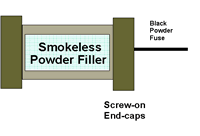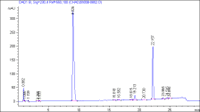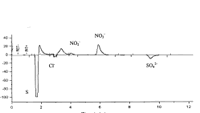Energetics facilitate the explosion. The base charge is nitrocellulose, a
polymer that gives body to the powder and allows extrudability. The addition
of nitroglycerine softens the propellant, raises the energy content, and
reduces hygroscopicity. Adding nitroguanidine reduces flame temperature,
embrittles the mixture at high concentration, and improves energy-flame
temperature relationship.
Stabilizers prevent the nitrocellulose and nitroglycerine from decomposing
by neutralizing nitric and nitrous acids that are produced during
decomposition. If the acids are not neutralized, they can catalyze further
decomposition. Some of the more common stabilizers used to extend the safe
life of the energetics are diphenylamine, methyl centralite, and ethyl
centralite.
Plasticizers reduce the need for volatile solvents necessary to colloid
nitrocellulose, soften the propellant, and reduce hygroscopicity. Examples
of plasticizers include nitroglycerine, dibutyl phthalate, dinitrotoluene,
ethyl centralite, and triacetin.
Flash suppressants interrupt free-radical chain reaction in muzzle gases and
work against secondary flash. They are typically alkali or alkaline earth
salts that either are contained in the formulation of the propellant or
exist as separate granules.
Deterrents coat the exterior of the propellant granules to reduce the
initial burning rate on the surface as well as to reduce initial flame
temperature and ignitability. The coating also broadens the pressure peak
and increases efficiency. Deterrents may be a penetrating type such as
Herkote,
dibutyl phthalate, dinitrotoluene, ethyl centralite, methyl centralite, or
dioctyl phthalate; or an inhibitor type such as Vinsol
resin.
Opacifiers enhance reproducibility primarily in large grains and keep radiant heat from penetrating the surface. They may also enhance the burning rate. The most common opacifier is carbon black.
Dyes are added mainly for identification purposes.
Other ingredients may be one of the following:
-
A graphite glaze used to coat the powder to improve flow and packing density as well as to reduce static sensitivity and increase conductivity
-
Bore erosion coatings applied as a glaze to reduce heat transfer to the barrel, but uncommon in small-arms propellants
-
Ignition aid coatings that are most commonly used in ball powders to improve surface oxygen balance

Figure 1-
Common smokeless powder morphologies
Chemical composition is one important characteristic defining smokeless propellants; however, another important characteristic is its morphology. Shape and size have a profound effect on the burning rate and power generation of a powder (Meyer 1987). Common particle shapes of smokeless propellants include balls, discs, perforated discs, tubes, perforated tubes, and aggregates (Bureau of Alcohol, Tobacco and Firearms 1994; Selavka et al. 1989). A few common types of smokeless powder morphologies can be seen in Figure 1 (Bender 1998).
Morphology also lends clues to whether a powder is single- or double-base (Bender 1998). Most tube and cylindrical powders are single-base, with the exception of the Hercules Reloaderseries. Disc powders, ball powders, and aggregates are double-base, with the exceptions being the PB and SR series powders manufactured by IMR Powder Company of Plattsburg, New York.
Except for ball powder, smokeless powder is manufactured by one of two general methods, differing in whether organic solvents are used in the process (Meyer 1987; Radford Army Ammunition Plant 1987). A single-base powder typically incorporates the use of organic solvents. Nitrocellulose of high- and low-nitrogen content are combined with volatile organic solvents, desired additives are blended with them, and the resulting mixture is shaped by extrusion and cut into specified lengths. The granules are screened to ensure consistency, and the solvents are removed. Various coatings, such as deterrents and graphite, are applied to the surface of the granules. The powder is dried and screened again, then blended to achieve homogeneity.
The manufacture of double-base powders requires the addition of nitroglycerine to the nitrocellulose. Two methods can be used. One method uses organic solvents, the other uses water. The organic solvent method mixes nitrocellulose and nitroglycerine with solvents and any desired additives to form a doughy mixture (Meyer 1987; National Research Council 1998; Radford Army Ammunition Plant 1987). The mixture is then pressed into blocks that can be fed into the extrusion press and cutting machine. The resulting granules are screened prior to solvent removal and the application of various coatings. The powder is dried, screened again, then blended to achieve homogeneity. The water method adds the nitroglycerine to a nitrocellulose water suspension to form a paste (Meyer 1987; Radford Army Ammunition Plant 1987). The water is removed by evaporation on hot rollers, then the dried powder is shaped by extrusion and cutting.
Triple-base powders use a solvent-based process similar to the double-base powder process (Meyer 1987; Radford Army Ammunition Plant 1987). Nitrocellulose and nitroglycerine are premixed with additives prior to the addition of a nitroguanidine solvent mixture. The nitroguanidine is incorporated into the overall mass without dissolving in the other materials. The final mixture is then extruded, cut, and dried.
The manufacture of smokeless ball powder requires a more specialized procedure (National Research Council 1998). Nitrocellulose, stabilizers, and solvents are blended into a dough, then extruded through a pelletizing plate and formed into spheres. The solvent is removed from the granules, and nitroglycerine is impregnated into the granules. The spheres are then coated with deterrents and flattened with rollers. Finally, an additional coating with graphite and flash suppressants is applied, and the batch is mixed to ensure homogeneity.
In the manufacturing process, smokeless powders are recycled and reworked (National Research Council 1998). When a powder within a batch is found to be unsatisfactory, it is removed and returned to the process for use in another lot. Manufacturers save money by recycling returns by distributors or the return of surplus or obsolete military powders. Hence, reworking and recycling the material assures good quality control of the final product, reduces costs by reusing materials, and reduces pollution by avoiding destruction by burning.
Distribution
The production of smokeless powders is big business in the United States, where approximately 10 million pounds of commercial smokeless powders are produced each year. Most of the powder is sold to the original-equipment manufacturers to be used for manufacturing ammunition. A large amount is sold to domestic and foreign militaries (National Research Council 1998). The rest is sold in individual canisters (ranging from ?-pound cans to 12- or 20-pound kegs) to gun stores or hunting and shooting clubs for hunters and target shooters who prefer to hand load their own ammunition.
There are several ways smokeless powders are distributed within the United States (National Research Council 1998). Some manufacturers, foreign or domestic, produce, package, and sell their own powders commercially. They may also sell in bulk to resellers and to original-equipment manufacturers that repackage and sell it under their own labels. The powder manufacturers and repackagers may disburse large quantities of canister powders to distributors who later sell to smaller distributors and wholesalers, who in turn, supply cans to dealers, gun shops, shooting clubs, and other retailers. At this point, consumers can purchase a 1-pound canister of powder for approximately $15 to $20 from a retailer, though the cost per pound can be cheaper if bought by the keg or acquired through a gun club (National Research Council 1998).
Manufacturers who produce smokeless powders for the U.S. military can distribute it either by selling the powder directly to the military or by selling them the preloaded ammunition. Powders can also be shipped to U.S. military subcontractors, foreign governments, or foreign loading companies for loading into military ammunition (National Research Council 1998).
Improvised Explosive Devices
An explosion is the result of energy-releasing reactions, generally accompanied by the creation of heat and gases (a notable exception is thermites). A distinguishing characteristic of an explosion is the rate at which the reaction proceeds. There are low-order and high-order explosives, based on the speed at which the explosives decompose. In low-order explosives, the process of decomposition, called the speed of deflagration or burning, produces heat, light, and a subsonic pressure wave. (The reaction speed of the deflagrating material is less than the speed of sound.) In high-order explosives, decomposition occurs at the speed of detonation, creating a supersonic shock wave that causes a virtually instantaneous buildup of heat and gases. Table 1 shows some differences in low-order and high-order explosives (Bureau of Alcohol, Tobacco and Firearms 1994; National Research Council 1998; Saferstein 1998).
|
Propellant Deflagration
|
High Explosive Detonation
|
||
| Initiation Method |
Ignition
|
Shock (from detonator or primary explosive)
|
|
| Reaction Time |
Milliseconds
|
Microseconds
|
|
| Pressure at Reaction Front |
3kbar
|
300kbar
|
|
| Velocity of Reaction Front |
0.6 km/sec
|
5-10 km/sec
|
|
| Temperature in Reaction Zone |
2000K
|
5000K
|
|
Table 1. Energetic Reactions
For low-order explosives, rapid deflagration causes the production of large volumes of expanding gases at the origin of the explosion. The heat energy from the explosion also causes the gases to expand. When the explosive charge is confined in a closed container, the sudden buildup of expanding pressure exerts high pressure on the container walls causing the container to stretch, balloon, then burst, releasing fragments of debris to nearby surroundings. It is this fragmented debris that produces the fatal result following the deflagration of an improvised explosive device (Saferstein 1998).
The safest and most powerful low-order explosive is smokeless powder. These powders decompose at rates up to 1,000 meters per second and produce a propelling action that makes them suitable for use in ammunition. However, the slower burning rate of smokeless powder should not be underestimated. The explosive power of smokeless powder is extremely dangerous when confined to a small container. In addition, certain smokeless powders with a high-nitroglycerine concentration can be induced to detonate. On the other hand, high-order explosives do not need containment to demonstrate their explosive effects (Saferstein 1998). These materials detonate at rates from 1,000 to 8,500 meters per second, producing a shock wave with an outward rush of gases at supersonic speeds. This effect proves to be more destructive than the fragmented debris.
The typical smokeless powder improvised explosive device, a pipe bomb, is roughly 10 inches long and 1 inch wide and contains approximately ? pound of powder. The materials used for these devices are cheap and readily obtainable at commercial establishments. Smokeless powder is attractive for use in improvised explosive devices, because it is readily available and has the potential for a powerful explosion when the powder is placed in a closed container (National Research Council 1998). Larger explosive devices usually use bulk materials such as ammonium nitrate and fuel oil, typically purchased in greater quantity at an even cheaper price.
Many types of containers are used in the construction of smokeless powder bombs (National Research Council 1998). Whereas metal pipes are most common, plastic pipes, cans, CO2 cartridges, and glass or plastic bottles have been used. These containers are often placed within larger packages for ease of transport and concealment.
Figure 2- Pipe Bomb
Another important part of the powder bomb is the initiation system, which provides the impetus to start the powder burning within its container (National Research Council 1998). A few examples include cigarettes, matches, and safety fuses (Scott 1994; Stoffel 1972). Improvised explosive devices utilizing smokeless powders within a robust container often include an initiation system, as shown in Figure 2 (Scott 1994).
Using data from the National Research Council on reported actual and attempted bombings using propellants during the five-year period from 1992-1996, Table 2 illustrates an average of 653 incidents per year involving the use of black and smokeless powders. Bombs containing black or smokeless powders were responsible for an average yearly count of about 10 deaths, 83 injuries, and almost $1 million in property damage for each of the five years. Using the National Research Council's data involving devices filled with black and smokeless powders, Table 3 illustrates the number of actual bombings that caused at least one death, one injury, or a minimum of $1,000 in property damage, as well as attempted bombings aimed at significant targets (National Research Council 1998).
Type of Explosive Used |
1992 |
1993 |
1994 |
1995 |
1996 |
Bomb containing smokeless powder/ black powder/black powder substitutes |
|||||
Total incidents |
667 |
637 |
696 |
624 |
644 |
Actual |
524 |
498 |
447 |
454 |
405 |
Attempted |
143 |
139 |
249 |
170 |
238 |
Deaths |
9 |
12 |
6 |
8 |
13 |
Injuries |
82 |
68 |
49 |
53 |
162 |
Property damage costs |
780K |
856K |
1.8M |
243K |
896K |
Table 2. All Reported Actual and Attempted
Bombings Using Propellants Between 1992 and 1996
NOTE: Actual and attempted bombings include incidents in which a device either exploded or was delivered to a target but did not explode. It does not include unexploded devices that were recovered by law enforcement personnel but not associated with a target.
|
|
Number of Incidents
|
Deaths
|
Injuries
|
|||
|
|
1992
|
1993
|
1994
|
1992-1994
|
1992-1994
|
|
| Total incidents |
260
|
258
|
294
|
27
|
199
|
|
| Actual |
166
|
160
|
122
|
27
|
199
|
|
| Attempted |
94
|
98
|
172
|
---
|
---
|
|
| Container |
|
|
|
|
|
|
| Pipe/metal |
158
|
169
|
158
|
19
|
122
|
|
| Pipe/plastic |
28
|
34
|
43
|
0
|
16
|
|
| Cardboard/paper |
7
|
3
|
4
|
0
|
2
|
|
| Other |
60
|
42
|
72
|
8
|
53
|
|
| Unknown |
7
|
10
|
17
|
0
|
6
|
|
Table 3. Significant Actual and Attempted Bombings Involving Devices Using Smokeless Powder, Black Powder, or Black Powder Substitutes
NOTE: Significant bombings represent actual bombings that caused at least one death, one injury, a minimum of $1,000 in property damage, or attempted bombings aimed at specified targets.
Analysis
Figure 3- Gradient HPLC analysis of an IMR 700X smokeless powder. Conditions Restek C-8 Column, 36-80% methanol/water gradient, 1 ml/min, UV detection at 230 nm. Figure courtesy of Chad Wissinger, Ohio University Figure 4- IC Analysis of H414 smokeless powder by Hodgdon. Conditions Nucleosil AnionMany methods for the analysis of smokeless powders have appeared over the years. These procedures have been extensively reviewed in a number of recent texts (Beveridge 1998; National Research Council 1998; Yinon and Zitrin 1993). The initial characterization of the powders is assessed using powder morphology and spot tests. Various instrumental analytical techniques allow organic additives such as nitroglycerine, diphenylamine, ethyl centralite, dinitrotoluene, and various phthalates to be detected and quantitated. These materials are usually analyzed using gas chromatography-mass spectrometry (Martz and Lasswell 1983) and liquid chromatography (Bender 1983; McCord and Bender 1998). Figure 3 illustrates the analysis of an IMR 700X powder using gradient high performance liquid chromatography (Wissinger and McCord 2002). More recently, methods involving capillary electrophoresis have also been shown to be effective (Northrop et al. 1991; Smith et al. 1999). Fourier transform infrared microscopy can be used for the identification of nitrocellulose (Zitrin 1998).
The process of manufacturing smokeless powders provides sources of inorganic ions that are present in postblast residue. These can be analyzed by ion chromatography. Although not unique to propellants, the presence of these ions can be used in forensic analysis to aid in the identification of the unknown powder. Potassium sulfate, sodium sulfate, potassium nitrate, barium nitrate, and other salts may be added during the processing of the powder. Nitrate, sulfate, hydrogen sulfide, chloride, and nitrite may appear as a result of the reactions for treating the cellulose to obtain nitrocellulose (Radford Army Ammunition Plant 1987). Figure 4 illustrates the analysis of H414 smokeless powder using ion chromatography. Also documented has been the presence of various cations found in the residue of smokeless powders after deflagration (Hall and McCord 1993; Miyauchi et al. 1998).
Conclusions
The wide variety of chemical components and the different morphologies of smokeless powders present a challenge for the forensic investigator. Physical characteristics of partially burned and unburned powder as well as the organic and inorganic materials that remain must be considered in the analysis of postblast residue. Although there are many techniques available for the determination of components in smokeless powder residue, the various formulations of powders make it necessary to continue the advancement of existing analyses and to develop new methods for testing the full range of available smokeless powders.


